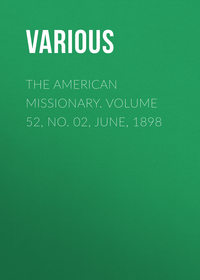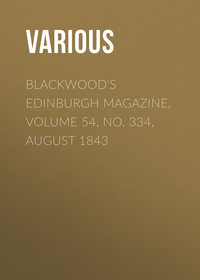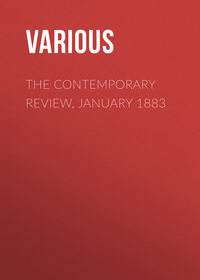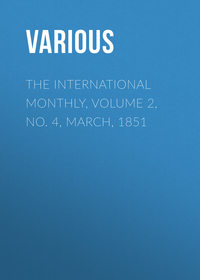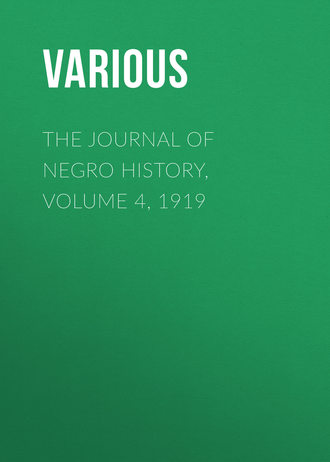 полная версия
полная версияThe Journal of Negro History, Volume 4, 1919
NOTES
Within a few years from the time the United States army will be reduced to a peace status, the Association for the Study of Negro Life and History will publish a scientific history of the Negro soldiers in the great war. As this effort will require a large outlay, it is earnestly desired that persons interested in the propagation of the truth will give this movement their support. A campaign for funds has begun and the encouragement hitherto received indicates that the amount necessary to finance this enterprise will be secured.
At present it is impossible to indicate exactly the extent of this work. It will be first necessary to make an extensive research into all of the sources of information as to the Negroes' participation in the war and when the data thus collected will have been properly digested, a more detailed description of the work may be forecasted. It is safe to say, however, that the work will consist of several volumes written by the Director of Research.
This same interest is set forth, as follows, in an item appearing in the December number of the Crisis:
"The National Association for the Advancement of Colored People has appropriated funds and commissioned the Director of Publications and Research to collect the data and compile a history of the Negro in the Great War.
"Dr. DuBois has invited a number of Negro scholars, soldiers and officials to form an Editorial Board, which will be able to issue an authentic, scientific and definitive history of our part in this war.
"The personnel of this board will be announced later. Meantime, we want the active coöperation of every person who can and will help. We want facts, letters and documents, narratives and clippings. Let us all unite to make the record complete. Correspondence may be directed to this office."
The following important announcement appeared in the December number of the Crisis:
TercentenaryThe husband of Pocahontas wrote in 1619: "About the last of August came a Dutch man of warre that sold us twenty Negars." From this beginning sprang the present twelve million Americans of Negro descent.
Next August will mark the Three Hundredth Anniversary of this vast transplantation of a race, which ranks easily as one of the most significant movements of mankind. Such an event can hardly be "celebrated," for it connoted too much of misery and human sorrow. On the other hand, it is too stern and meaningful a happening to be forgotten. For this reason, a group of thirty-three colored men met in New York, October 19, 1918, at the invitation of a committee appointed by the National Association for the Advancement of Colored People.
They determined to inaugurate "A Solemn Memorial of the Tercentenary of the Transplanting of the Negro race to the United States." In order, however, to give all sections and interests of the Negro race adequate voice and representation in these plans, this committee set about choosing a Committee of "Three Hundred and More," in whose hands the Memorial will take final shape. This Committee is now being chosen and will meet in New York early in January, 1919.
The Linchoten Vereeniging has published for Mr. E. C. Godee Mossbergen two volumes of Reizen in Zuid-Afrika in de Hollandse Tijd.
From the press of Longsman two volumes bearing on Africa have been published. One is by Sir Hugh Clifford, entitled the German Colonies, with special relation to the native population of Africa. The other, by H. C. O'Neill, is the War in Africa and the Far East, dealing largely with the conquest of the German colonies.
Houghton, Mifflin and Company have published a study entitled Lincoln in Illinois by Miss Octavia Roberts. This work is largely a compilation of the recollections of his contemporaries.
To extend the work of the Association the Director of Research is now making an effort to secure the cooperation of five persons who, like Mr. Julius Rosenwald, will contribute $400 annually to the support of this cause. Mr. Moorfield Storey and Mr. Cleveland H. Dodge have each pledged themselves to give this amount. It is earnestly hoped that other philanthropists will subscribe.
The Journal of Negro History
Vol. IV—April, 1919—No. 2
THE CONFLICT AND FUSION OF CULTURES WITH SPECIAL REFERENCE TO THE NEGRO 79
Under ordinary circumstances the transmission of the social tradition is from the parents to the children. Children are born into society and take over its customs, habits, and standards of life simply, naturally, and without conflict. But it will at once occur to any one that the life of society is not always continued and maintained in this natural way, by the succession of parents and children. New societies are formed by conquest and by the imposition of one people upon another. In such cases there arises a conflict of cultures and as a result the process of fusion takes place slowly and is frequently not complete. New societies are frequently formed by colonization, in which case new cultures are grafted on to older ones. The work of missionary societies is essentially one of colonization in this sense.
Finally we have societies growing up, as in the United States, by immigration. These immigrants, coming as they do from all parts of the world, bring with them fragments of divergent cultures. Here again the process of assimilation is slow, often painful, not always complete. In the case where societies are formed and maintained by adoption, that is by immigration, the question arises: How far is it possible for a people of a different race and a different culture to take over the traditions and social inheritance of another and an alien people? What are the conditions which facilitate this transmission and, in general, what happens when people of different races and cultures are brought together in the intimate relations of community life?
These questions have already arisen in connection with the education of the Negro in America and with the work of foreign missions. If the schools are to extend and rationalize the work they are already doing in the Americanization of the immigrant peoples, questions of this sort may become actual in the field of pedagogy. This paper is mainly concerned with the Negro, not because the case of the Negro is more urgent than or essentially different from that of the immigrant, but because the materials for investigation are more accessible.
Admitting, as the anthropologists now seem disposed to do, that the average native intelligence in the races is about the same, we may still expect to find in different races certain special traits and tendencies which rest on biological rather than cultural differences. For example, over and above all differences of language, custom or historic tradition, it is to be presumed that Teuton and Latin, the Negro and the Jew—to compare the most primitive with the most sophisticated of peoples—have certain racial aptitudes, certain innate and characteristic differences of temperament which manifest themselves especially in the objects of attention, in tastes and in talents. Is the Jewish intellectual, for example, a manifestation of an original and peculiar endowment of the Jewish race or is he rather a product of traditional interest and emphasis characteristic of Jewish people—a characteristic which may be explained as an accommodation to the long-continued urban environment of the race?80 Is the Negro's undoubted interest in music and taste for bright colors, commonly attributed to the race, to be regarded as an inherent and racial trait or is it merely the characteristic of primitive people? Is Catholicism to be regarded as the natural manifestation of the Latin temperament as it has been said that Protestantism is of the Teutonic?
Here are differences in the character of the cultural life which can scarcely be measured quantitatively in terms of gross intellectual capacity. Historical causes do not, it seems, adequately account for them. So far as this is true we are perhaps warranted in regarding them as modifications of transmitted tradition due to innate traits of the people who have produced them. Granted that civilization, as we find it, is due to the development of communication and the possibility of mutual exchange of cultural materials, still every special culture is the result of a selection and every people borrows from the whole fund of cultural materials not merely that which it can use but which, because of certain organic characteristics, it finds stimulating and interesting.
The question then resolves itself into this: How far do racial characteristics and innate biological interests determine the extent to which one racial group can and will take over and assimilate the characteristic features of an alien civilization? How far will it merely take over the cultural forms, giving them a different content or a different inflection? This problem, so far as it is related to the lives of primitive peoples, has already been studied by the ethnologists. Rivers, in his analysis of the cultures of Australian people, has found that what we have hitherto regarded as primitive cultures are really fusions of other and earlier forms of culture.81 The evidence of this is the fact that the fusion has not been complete. In the process of interchange it frequently happens that what Rivers calls the "fundamental structure" of a primitive society has remained unchanged while the relatively formal and external elements of alien culture only have been taken over and incorporated with it.
There are indications also that, where cultural borrowings have taken place, the borrowed elements have for the people who have taken them over a meaning different from what they had for the people from whom they were borrowed. W.J. McGee, in an article entitled "Piratical Acculturation," has given an interesting illustration of this fact.82 McGee's observations of the Beri Indians go to show that they imitated the weapons of their enemies, but that they regarded them as magical instruments and the common people did not even know their names. There are numerous other illustrations of this so-called "piratical acculturation" among the observations of ethnologists. It is said that the Negroes in Africa, when they first came into possession of the white man's guns, regarded them as magical instruments for making a noise and used them, as the Germans used the Zeppelins and the newspapers, merely to destroy the enemy's morale.
No doubt the disposition of primitive peoples is to conceive everything mystically, or animistically, to use the language of ethnology, particularly where it concerns something strange. On the other hand, when the primitive man has encountered among the cultural objects to which civilization has introduced him, something which he has been able to make immediately intelligible to himself, he has at once formed a perfectly rational conception of it. Some years ago at Lovedale, South Africa, the seat of one of the first successful industrial mission schools, there was an important ceremony to which all the native African chiefs in the vicinity were formally invited. It was the introduction and demonstration of the use of the plow, the first one that had ever been seen in those parts. The proceedings were followed with great interest by a large gathering of natives. When the demonstration was finished one old chief turned to his followers and said with great conviction: "This is a great thing which the white man has brought us. One hoe like that is worth as much as ten wives." An African chief could hardly have expressed appreciation of this one fundamental device of our civilization in more pragmatic or less mystical terms. The wise old chief grasped the meaning of the plow at once, but this was because he had been pre-adapted by earlier experience to do so.
It is the subjective, historic and ultimately, perhaps, racial and temperamental factor in the lives of peoples which makes it difficult, though not impossible, perhaps, to transmit political and religious institutions to people of a different racial type and a different social tradition. William James' essay, "On a Certain Blindness in Human Beings," in which he points out how completely we are likely to miss the point and mistake the inner significance of the lives of those about us, unless we share their expedience, emphasizes this fact. If then the transmission and fusion of cultures is slow, incomplete and sometimes impossible, it is because the external forms, the formulas, technical devices of every social tradition can be more easily transmitted than the aims, the attitudes, sentiments and ideals which attach to them are embodied in them. The former can be copied and used; the latter must be appreciated and understood.
For a study of the acculturation process, there are probably no materials more complete and accessible than those offered by the history of the American Negro. No other representatives of a primitive race have had so prolonged and so intimate an association with European civilization, and still preserved their racial identity. Among no other people is it possible to find so many stages of culture existing contemporaneously. It has been generally taken for granted that the Negro brought a considerable fund of African tradition and African superstition from Africa to America. One not infrequently finds in the current literature and even in standard books upon the Negro, references to voodoo practices among the Negroes in the Southern States. As a matter-of-fact the last authentic account which we have of anything approaching a Negro nature worship in the United States took place in Louisiana in 1884. It is described by George W. Cable in an article on "Creole Slave Songs" which appeared in the Century Magazine in 1886. In this case it seems to have been an importation from the West Indies. I have never found an account of a genuine instance of voodoo worship elsewhere in the United States, although it seems to have been common enough in the West Indies at one time.
My own impression is that the amount of African tradition which the Negro brought to the United States was very small. In fact, there is every reason to believe, it seems to me, that the Negro, when he landed in the United States, left behind him almost everything but his dark complexion and his tropical temperament. It is very difficult to find in the South today anything that can be traced directly back to Africa. This does not mean that there is not a great deal of superstition, conjuring, "root doctoring" and magic generally among the Negroes of the United States. What it does mean is that the superstitions we do find are those which we might expect to grow up anywhere among an imaginative people, living in an intellectual twilight such as exists on the isolated plantations of the Southern States. Furthermore, this superstition is in no way associated, as it is in some of the countries of Europe, southern Italy for example, with religious beliefs and practices. It is not part of Negro Christianity. It is with him, as it is with us, folk-lore pure and simple. It is said that there are but two African words that have been retained in the English language. One of these is the word Buckra, from which comes Buckra Beach in Virginia. This seems remarkable when we consider that slaves were still brought into the United States clandestinely up to 1862.83
The explanation is to be found in the manner in which the Negro slaves were collected in Africa and the manner in which they were disposed of after they arrived in this country. The great markets for slaves in Africa were on the West Coast, but the old slave trails ran back from the coast far into the interior of the continent, and all the peoples of Central Africa contributed to the stream of enforced emigration to the New World. In the West Indies a good deal was known among slave-traders and plantation owners about the character and relative value of slaves from different parts of Africa, but in the United States there was less knowledge and less discrimination. Coming from all parts of Africa and having no common language and common tradition, the memories of Africa which they brought with them were soon lost.
There was less opportunity in the United States also than in the West Indies for a slave to meet one of his own people, because the plantations were considerably smaller, more widely scattered and, especially, because as soon as they were landed in this country, slaves were immediately divided and shipped in small numbers, frequently no more than one or two at a time, to different plantations. This was the procedure with the very first Negroes brought to this country. It was found easier to deal with the slaves, if they were separated from their kinsmen.
On the plantation they were thrown together with slaves who had already forgotten or only dimly remembered their life in Africa. English was the only language of the plantation. The attitude of the slave plantation to each fresh arrival seems to have been much like that of the older immigrant towards the greenhorn. Everything that marked him as an alien was regarded as ridiculous and barbaric.84 Furthermore, the slave had in fact very little desire to return to his native land. I once had an opportunity to talk with an old man living just outside of Mobile, who was a member of what was known as the African colony. This African colony represented the cargo of one of the last slave ships successful in landing in this country just at the opening of the war. The old man remembered Africa and gave me a very interesting account of the way in which he was captured and brought to America. I asked him if he had ever wished to return. He said that a missionary who had been in their country and spoke their language had visited them at one time. This missionary offered to send them back to Africa and even urged them to go. "I told him," said the old man, "I crossed the ocean once, but I made up my mind then never to trust myself in a boat with a white man again."
The fact that the Negro brought with him from Africa so little tradition which he was able to transmit and perpetuate on American soil, makes that race unique among all peoples of our cosmopolitan population. Other peoples have lost, under the disintegrating influence of the American environment, much of their cultural heritage. None have been so utterly cut off and estranged from their ancestral land, traditions and people. It is just because of this that the history of the Negro offers exceptional materials for determining the relative influence of temperamental and historical conditions upon the process by which cultural materials from one racial group are transmitted to another; for, in spite of the fact that the Negro brought so little intellectual baggage with him, he has exhibited a rather marked ethnical individuality in the use and interpretation of the cultural materials to which he has had access.
The first, and perhaps the only distinctive institution which the Negro has developed in this country is the Negro church, and it is in connection with his religion that we may expect to find, if anywhere, the indications of a distinctive Afro-American culture. The actual conditions under which the African slaves were converted to Christianity have never been adequately investigated. We know, in a general way, that there was at first considerable opposition to admitting the Negro into the church because it was feared that it would impair the master's title to his slaves. History records too that the house servants were very early admitted to churches and that in many cases masters went to considerable pains to instruct those servants who shared with them the intimacy of the household.85 It was not, however, until the coming of the new, free and evangelistic types of Christianity, the Baptists and the Methodists, that the masses of the black people, that is, the plantation Negroes, found a form of Christianity that they could make their own.
How eagerly and completely the Negro did take over the religion of these liberal denominations may be gathered from some of the contemporary writings, which record the founding of the first Negro churches in America. The first Negro church in Jamaica was founded by George Liele, shortly after the close of the Revolutionary War. George Liele had been a slave in Savannah, but his master, who was a Tory, emigrated to Jamaica upon the evacuation of that city. Andrew Bryan in Savannah was one of Liele's congregation. He was converted, according to the contemporary record, by Liele's exposition of the text "You must be born again!" About eight months after Liele's departure, Andrew began to preach to a Negro congregation, "with a few white." The colored people had been permitted to erect a building at Yamacraw, but white people in the vicinity objected to the meetings and Bryan and some of his associates were arrested and whipped. But he "rejoiced in his whippings" and holding up his hand declared "he would freely suffer death for the cause of Jesus Christ." Bryan's master interceded for him and "was most affected and grieved" at his punishment. He gave Bryan and his followers a barn to worship in, after Chief Justice Osbourne had given them their liberty. This was the origin of what was probably the first Negro church in America.
George Liele and Andrew Bryan were probably not exceptional men even for their day. The Rev. James Cook wrote of Bryan: "His gifts are small but he is clear in the grand doctrines of the Gospel. I believe him truly pious and he has been the instrument of doing more good among the poor slaves than all the learned doctors in America."86 The significant thing is that, with the appearance of these men, the Negroes in America ceased to be a mission people. At least, from this time on, the movement went on of its own momentum, more and more largely under the direction of Negro leaders. Little Negro congregations, under the leadership of Negro preachers, sprang up wherever they Were tolerated. Often they were suppressed, more often they were privately encouraged. Not infrequently they met in secret.
In 1787 Richard Allen and Absolom Jones had formed in Philadelphia the Free African Society, out of which four years later, in 1790, arose the first separate denominational organization of Negroes, the African Methodist-Episcopal Church. George Liele, Andrew Bryan, Richard Allen, and the other founders of the Negro church were men of some education, as their letters and other writings show. They had had the advantage of life in a city environment and the churches which they founded were in all essentials faithful copies of the denominational forms as they found them in the churches of that period.
The religion of the Negroes on the plantation was then, as it is today, of a much more primitive sort. Furthermore, there were considerable differences in the cultural status of different regions of the South and these differences were reflected in the Negro churches. There was at that time, as there is today, a marked contrast between the Upland and the Sea Island Negroes. Back from the coast the plantations were smaller, the contact of the master and slave were more intimate. On the Sea Island, however, where the slaves were and still are more completely isolated than elsewhere in the South, the Negro population approached more closely to the cultural status of the native African. The Sea Islands were taken possession of in the first years of the war by the Federal forces and it was here that people from the North first came in contact with the plantation Negro of the lower South. They immediately became interested in the manners and customs of the Island Negroes, and from them we have the first accurate accounts of their folk-lore and sayings.
The Sea Island Negroes speak a distinct dialect and retain certain customs which are supposed to be of African origin. It is, however, in their religious practices that we have the nearest approach to anything positively African. This has undoubtedly the characteristics of primitive ritual. But this does not mean that it is African in origin. It seems to me more likely that it is to be interpreted as a very simple and natural expression of group emotion, which is just beginning to crystallize and assume a formal character. The general tone of these meetings is that of a religious revival in which we expect a free and uncontrolled expression of religious emotion, the difference being that in this case the expression of the excitement is beginning to assume a formal and ritualistic character.







